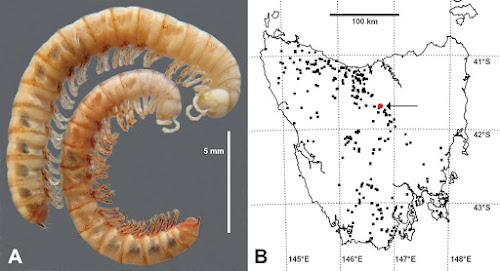 |
| Kebodesmus zonarius Mesibov & Rodriguez, 2020 |
Abstract
Kebodesmus zonarius gen. nov. et sp. nov. is only known from a small area on the Great Western Tiers in northern Tasmania, Australia, and like species of Paredrodesmus Mesibov, 2003 has no detectable paranota on the diplosegments. The gonopod telopodite of the new species is divided into a large, lateral, cowl-like structure, a solenomere and a medial branch with three processes.
Keywords: Australia, Dalodesmidae, Diplopoda, Polydesmida, Tasmania
Order Polydesmida Pocock, 1887
Suborder Dalodesmidea Hoffman, 1980
Family Dalodesmidae Cook, 1896
Kebodesmus Mesibov & Rodriguez, gen. nov.
Type species: Kebodesmus zonarius sp. nov., by present designation.
Diagnosis: Closely similar in general appearance to species of Paredrodesmus Mesibov, 2003, but distinguished from Paredrodesmus species in having H+20 body plan rather than H+19; normal pore formula rather than 5, 7–18; sphaerotrichomes on legs rather than no sphaerotrichomes; dorsal spinnerets within depression below epiproct tip rather than on epiproct rim; and a phenolic defensive secretion rather than no odour detectable from living specimens. Distinguished from all other Tasmanian Dalodesmidea (apart from Paredrodesmus) by the complete absence of paranota or traces of paranota on the diplosegments, and by the deep division of the gonopod telopodite.
Name: In honour of Kevin Bonham (Ke – bo), Tasmanian naturalist, collector and identifier, who emailed the senior author in May 2020 to say he had collected a millipede “whose gonopods I couldn’t even remotely match to anything”.
Remarks: In gonopod structure Kebodesmus gen. nov. is unlike any of the undescribed Dalodesmidae so far examined in mainland Australian collections, and unlike any of the New Zealand Dalodesmidae described by Johns (1964, 1970). The gonopod in the new species is similar to that of Abatodesmus velosoi Demange & Silva, 1971, a H+20 dalodesmid from the Cordillera de Nahuelbuta in southern Chile, but differs in having the solenomere base clearly separated from the other telopodite processes.
Kebodesmus zonarius Mesibov & Rodriguez, sp. nov.
Name: Latin zonarius, zonal, adjective. This species appears to be restricted to a narrow altitudinal zone on Tasmania’s Great Western Tiers.
Distribution and ecology: So far known from four sites in wet eucalypt forest at ca 800 m a.s.l. on the Great Western Tiers in northern Tasmania, south of the town of Deloraine, with a linear range extent of less than 1 km (Fig. 1B). Adults and juveniles are found in patches of richly organic soil and humus in the forest, which is dominated by Eucalyptus delegatensis subsp. tasmaniensis Boland. The new species co-occurs in humus with the native dalodesmids Lissodesmus alisonae Jeekel, 1984 and L. perporosus Jeekel, 1984, but was found in greater numbers than the other two species during searches in 2020.
Robert Mesibov and Juanita Rodriguez. 2020. A New Genus and Species of Narrow-range Millipede (Diplopoda, Polydesmida, Dalodesmidae) from Tasmania, Australia. ZooKeys. 966: 1-8. DOI: 10.3897/zookeys.966.56308

